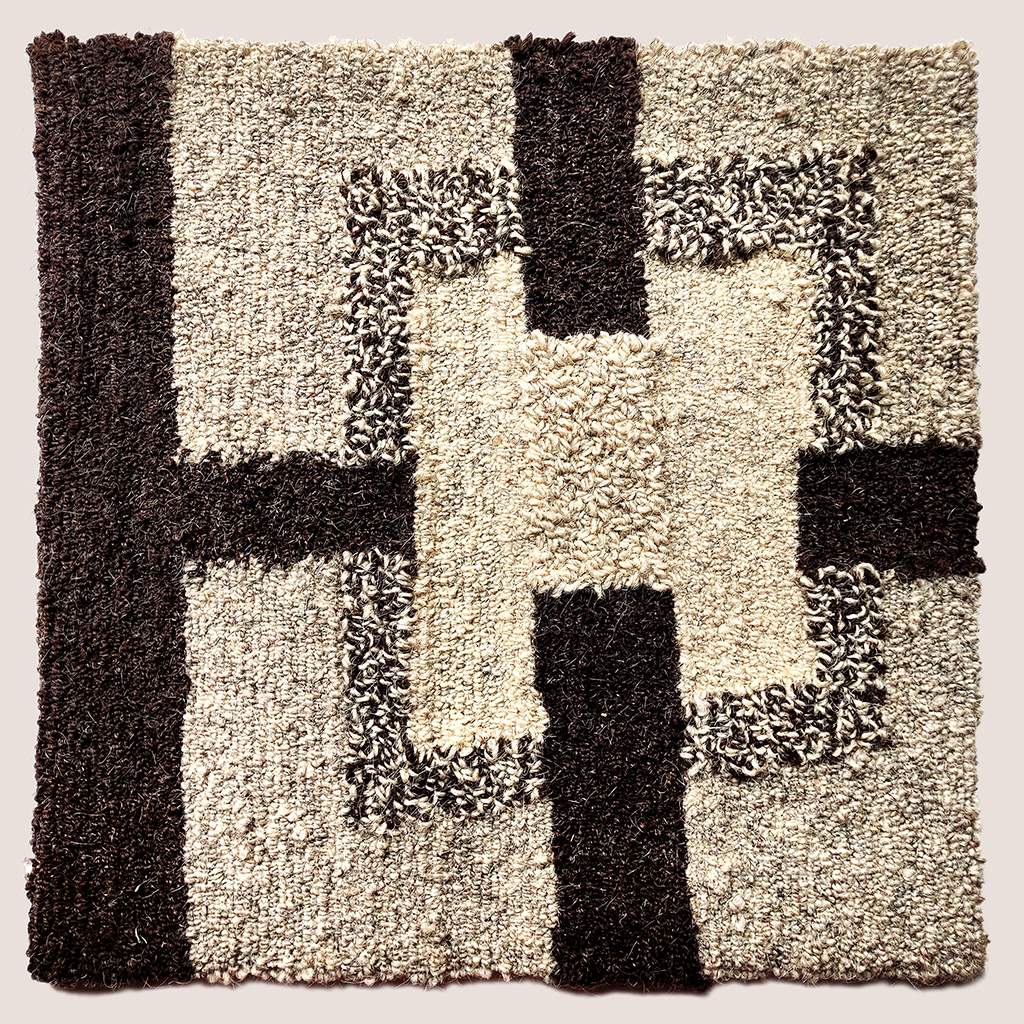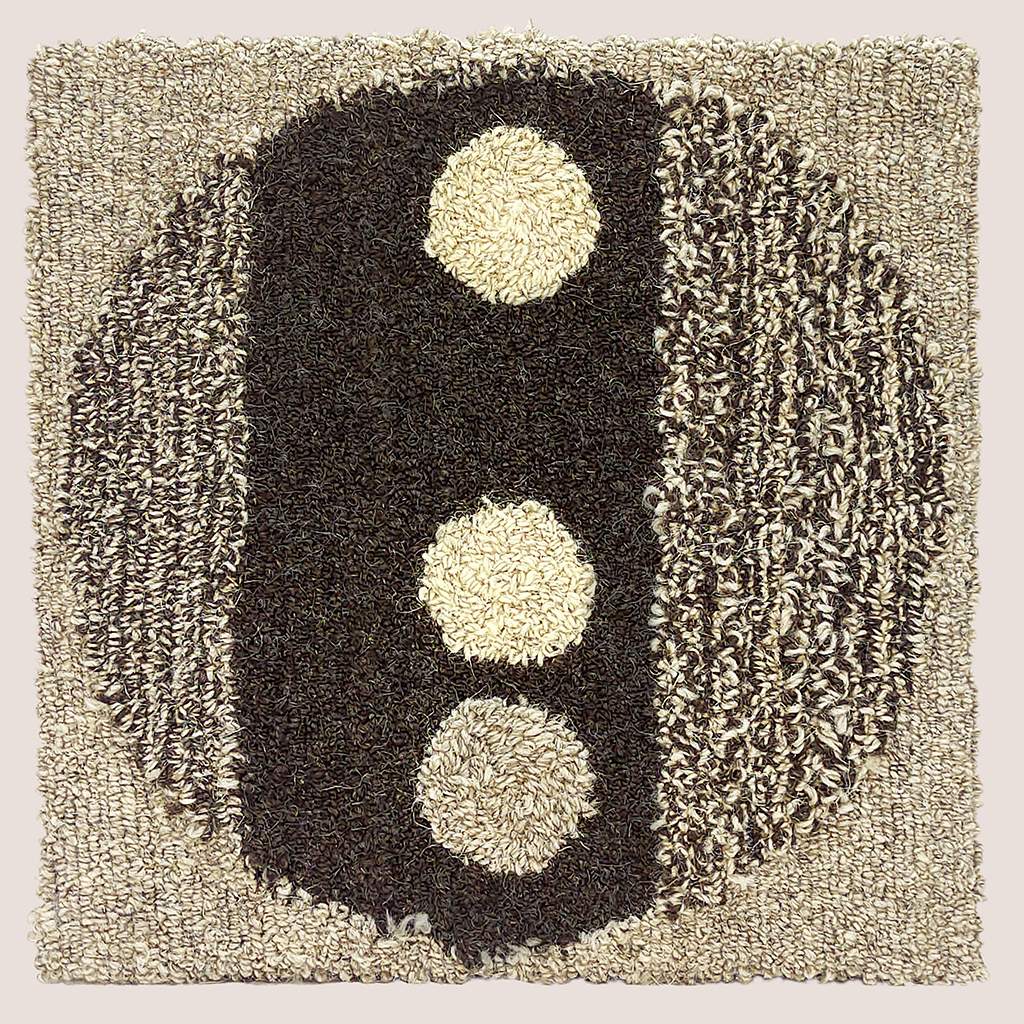



Desde hace algunos años creo objetos que cuentan historias que son el hilo conductor para aunar pasado, presente y futuro de las personas a través de la lana.
Una propuesta artística en unos casos y funcional en otros que sirva de reflexión y difusión del mundo ovino y de la materia prima que estamos tratando: nuestra lana, con una temática de la cultura y tradición del País Vasco donde vivo. Siendo la manera de transmitir esta herencia a la vida cotidiana de hoy en día.
En los procesos de creación intento aunar técnicas y herramientas: las tradicionales como el fieltro-bordado-tejido realizado con mis manos y las digitales como el diseño, corte y grabado con laser, moldeado y reservas con impresión 3D, etc. Buscando un equilibrio entre la tradición y lo contemporáneo.
En esa investigación y decisión de renovación de las técnicas tradicionales, desarrollo una serie de trabajos en el que empleo la “técnica de mechón” o “enganchar” para la realización de alfombras y tapices cuyos orígenes se remontan a 1840, y que ha llegado hasta nuestros días pasando por diferentes procesos de evolución: sencillas herramientas manuales que han dado paso a sencillas máquinas eléctricas manejadas a mano hasta llegar a lo digital con la máquina anclada a una estructura metálica donde se desliza sobre la superficie textil controlada por un ordenador que suministra las órdenes de ejecución del diseño que previamente se ha introducido en el programa adecuado.
Se cree que su origen pudiera estar en Inglaterra, reutilizando los hilos de desechos de las fábricas textiles. Era la forma en que la gente más pobre hiciera sus alfombras para su propio uso. Esta práctica se extendió a Estados Unidos y Canadá con la inmigración.
El origen de esta técnica está en el Gancho y en la búsqueda de mejoras y más rapidez aparece la Aguja hueca con orificio, lo que denominamos como Punch. Se desarrollaron una gran cantidad de herramientas y modelos manuales que permitían mecanizar y agilizar el trabajo a partir de esta aguja hueca con orificio. El resultado es la inserción del material (lana o tiras de textil) en forma de bucle, sin realización de nudo y que luego puede ser cortado, se denomina tufter.
Esta investigación me ha proporcionado ampliar las técnicas en el trabajo. Incorporar esta técnica me aporta integrar lana en otro estado superior de procesado de las fibras. La lana hilada con sus colores, matices y grosores avecinan buenas perspectivas creativas.
E1, E2, E3 y E4, 2022
Materiales: lana carranzana, soporte textil industrial, soporte textil de yute
Técnica: tufting y punch
Medidas:
45 x 45 cm.
Obra presentada y expuesta en:
BESTIARIUM, Sala de exposiciones Centro Santo Domingo, Pedraza, Segovia, 12-15 mayo 2023
Las piezas superiores han participado en la edición de Madrid Craft Week del 11 al 20 de noviembre de 2022. Una iniciativa de la ACTM donde 12 creadoras textiles exponen sus trabajos en 12 escaparates del Barrio de las Letras.
For some years now I have been creating objects that tell stories that are the common thread to bring together the past, present and future of people through wool.
An artistic proposal in some cases and functional in others that serves as a reflection and dissemination of the world of sheep and the raw material we are dealing with: our wool, with a theme of the culture and tradition of the Basque Country where I live. This is a way of transmitting this heritage to everyday life today.
In the creative processes I try to combine techniques and tools: traditional ones such as felting-embroidery-fabric made with my hands and digital ones such as design, laser cutting and engraving, moulding and 3D printing, etc. Seeking a balance between tradition and the contemporary.
In this research and decision to renew traditional techniques, I develop a series of works in which I use the "tufting technique" or "hooking" to make carpets and tapestries whose origins date back to 1840, and which has come down to the present day through different processes of evolution: simple hand tools that have given way to simple electric machines operated by hand until reaching the digital stage with the machine anchored to a metal structure where it slides over the textile surface controlled by a computer that provides the orders for the execution of the design that has previously been entered into the appropriate programme.
It is thought to have originated in England, reusing waste yarns from textile mills. It was a way for poorer people to make carpets for their own use. This practice spread to the United States and Canada with immigration.
The origin of this technique is in the Hook and in the search for improvements and more speed the hollow needle with a hole appears, what we call Punch. A large number of tools and manual models were developed that allowed mechanising and speeding up the work from this hollow needle with a hole. The result is the insertion of the material (wool or textile strips) in the form of a loop, without a knot, which can then be cut, called tufter.
This research has allowed me to broaden the techniques in my work. Incorporating this technique allows me to integrate wool in another superior state of fibre processing. The spun wool with its colours, shades and thicknesses offers good creative perspectives.
E1, E2, E3 and E4, 2022
Materials: carranzana wool, industrial textile backing, jute textile backing
Technique: tufting and punch
Size:
45 x 45 cm.
Work presented and exhibited in:
BESTIARIUM, Centro Santo Domingo Exhibition Hall, Pedraza, Segovia, 12-15 May 2023
The top pieces have participated in the edition of Madrid Craft Week from 11 to 20 November 2022. An initiative of the ACTM where 12 textile creators exhibit their work in 12 shop windows in the Barrio de las Letras.
 Reverso. Aplicación del adhesivo
Reverse side. Adhesive application
Reverso. Aplicación del adhesivo
Reverse side. Adhesive application
 Lanas, razas autóctonas de Euskal Herria
Wool, native breeds of the Euskal Herria
Lanas, razas autóctonas de Euskal Herria
Wool, native breeds of the Euskal Herria
 Anverso, piezas fuera del bastidor
Front side, parts outside the frame
Anverso, piezas fuera del bastidor
Front side, parts outside the frame
